

Coreference. Types of coreference[edit] Anaphora a.
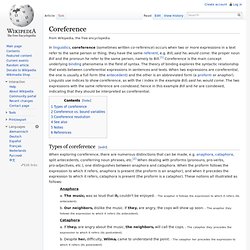
The musici was so loud that iti couldn't be enjoyed. - The anaphor it follows the expression to which it refers (its antecedent). b. Our neighborsi dislike the music. Cataphora a. B. Split antecedents a. B. Coreferring noun phrases a. B. Coreference vs. bound variables[edit] Semanticists and logicians sometimes draw a distinction between coreference and what is known as a bound variable.[3] An instance of a bound variable can look like coreference, but from a technical standpoint, one can argue that it actually is not.
A. B. Quantified expressions such as every student and no student are, from a technical standpoint, not referential. C. This sentence is ambiguous. Coreference resolution[edit] Automatic Content Extraction (ACE) Evaluation. What is Automatic Content Extraction (ACE)?
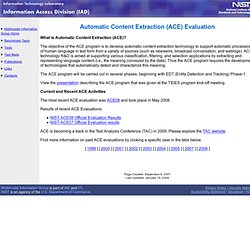
The objective of the ACE program is to develop automatic content extraction technology to support automatic processing of human language in text form from a variety of sources (such as newswire, broadcast conversation, and weblogs). ACE technology R&D is aimed at supporting various classification, filtering, and selection applications by extracting and representing language content (i.e., the meaning conveyed by the data). Thus the ACE program requires the development of technologies that automatically detect and characterize this meaning. The ACE program will be carried out in several phases, beginning with EDT (Entity Detection and Tracking) Phase-1. View the presentation describing the ACE program that was given at the TIDES program kick-off meeting.
Current and Recent ACE Activities The most recent ACE evaluation was ACE08 and took place in May 2008. Results of recent ACE Evaluations: LDC - Projects - ACE - Automatic Content Extraction. Collaborations play an important role in many LDC activities.
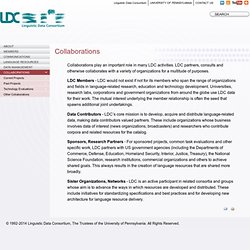
LDC partners, consults and otherwise collaborates with a variety of organizations for a multitude of purposes. LDC Members - LDC would not exist if not for its members who span the range of organizations and fields in language-related research, education and technology development. Universities, research labs, corporations and government organizations from around the globe use LDC data for their work. The mutual interest underlying the member relationship is often the seed that spawns additional joint undertakings. Data Contributors - LDC’s core mission is to develop, acquire and distribute language-related data, making data contributors valued partners.
Cataphora. In linguistics, cataphora /kəˈtæfərə/ (from Greek, καταφορά, kataphora, “a downward motion” from κατά, kata, “downwards” and φέρω, pherō, “I carry”) is used to first insert an expression or word that co-refers with a later expression in the discourse.[1] An example of strict, sentence-internal cataphora in English is the following sentence: When he arrived home, John went to sleep.
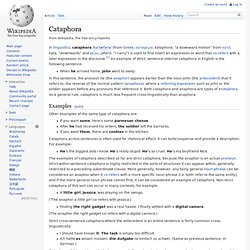
Examples[edit] Other examples of the same type of cataphora are: If you want some, here's some parmesan cheese.After he had received his orders, the soldier left the barracks.If you want them, there are cookies in the kitchen. Cataphora across sentences is often used for rhetorical effect. He's the biggest slob I know.
The examples of cataphora described so far are strict cataphora, because the anaphor is an actual pronoun. A little girl, Jessica, was playing on the swings. ('The anaphor a little girl co-refers with Jessica.) Finding the right gadget was a real hassle. See also[edit] References[edit] Anaphora (linguistics) Anaphora is an important concept for different reasons and on different levels: first, anaphora indicates how discourse is constructed and maintained; second, anaphora binds different syntactical elements together at the level of the sentence; third, anaphora presents a challenge to natural language processing in computational linguistics, since the identification of the reference can be difficult; and fourth, anaphora tells us some things about how language is understood and processed, which is relevant to fields of linguistics interested in cognitive psychology.[2] The term anaphora is actually used in two ways.
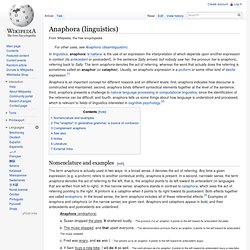
In a broad sense, it denotes the act of referring. Any time a given expression (e.g. a proform) refers to another contextual entity, anaphora is present. In a second, narrower sense, the term anaphora denotes the act of referring to the left, that is, the anaphor points to its left toward its antecedent (in languages that are written from left to right). Anaphora (endophora) MegaM.